On May 20, 2015 Mike Babcock was named head coach of the Toronto Maple Leafs. Four years later and halfway through his contract, he’s still behind the bench – at least for now.
General manager Kyle Dubas wouldn’t show his hand when asked about Babcock’s future at the season-ending press conference on April 25. Just two days after the Maple Leafs were eliminated from Stanley Cup contention by the Boston Bruins, reporters were wondering about Babcock’s status with the club.
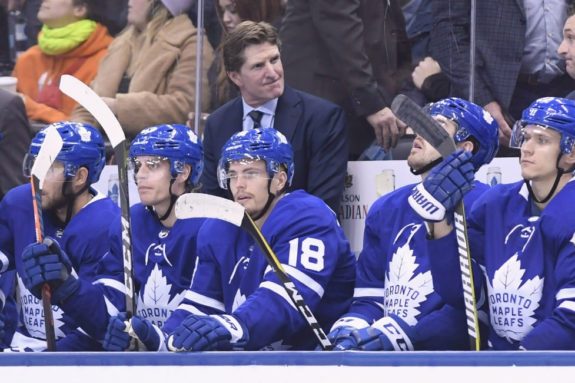
“I wouldn’t give any guarantee to anybody in our whole organization, starting with me,” Dubas said. “We’ll do what we think is best and we’ll let you know when we know.”
The 33-year-old GM added that he would first be evaluated by team president Brendan Shanahan, and only then would he be able to make a decision on Babcock and the rest of his staff. A week and a half later, Dubas delivered his vote of confidence, confirming that Babcock would return as coach of the Maple Leafs for the 2019-20 season.
“We’re all in on Mike and Mike is all in on us,” Dubas said to TSN’s Bob McKenzie.
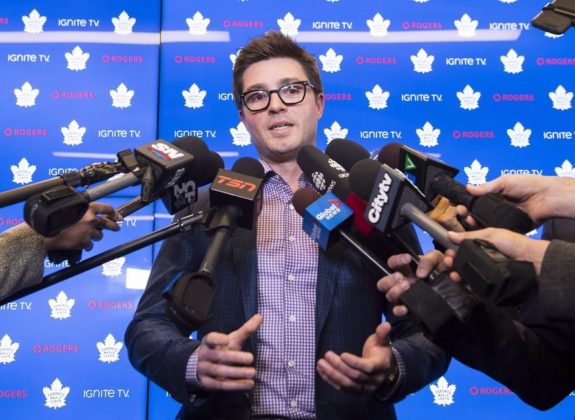
Predictably, but also interestingly, Dubas added, “There are things we need to improve upon. There are things we need to do to adapt and evolve and continue to get better. As an organization, we believe we can do that together.”
Predictable because any team that’s eliminated in the first round has things they’ll want to improve on. Interesting because given the criticisms of Babcock over the course of the regular season, and especially in the playoffs, you can’t help but think that most of the adapting and evolving will need to come on the coach’s end. If Babcock isn’t able to show that he can adapt, the league’s highest paid coach may find himself out of a job before his deal is up.
Evaluations of Babcock’s coaching ability will vary depending on who you ask, but even the staunchest defender of the Maple Leafs bench boss would have some complaints after last season. Regardless of where you stand on the Babcock debate, those complaints are generally consistent, falling into three categories: special teams, ice time allocation, and line combinations.
Leafs Special Teams
The issue of special teams is intricate because it was the assistant coaches – not Babcock – who were tasked with running their respective units. We’ll dive into each unit and its coach individually, but that doesn’t mean Babcock is without blame for Toronto’s faltering special teams.
The Power Play
For all the talent on the roster, it would have been within reason to expect at least a top-five power play. Unfortunately, that wasn’t the case last season.
The Maple Leafs finished the season ranked 8th in the league on the power play at a respectable 21.8 percent. But it’s hard to be happy with “respectable” when you’ve got the firepower of Auston Matthews, John Tavares, Mitch Marner, and others at your disposal.
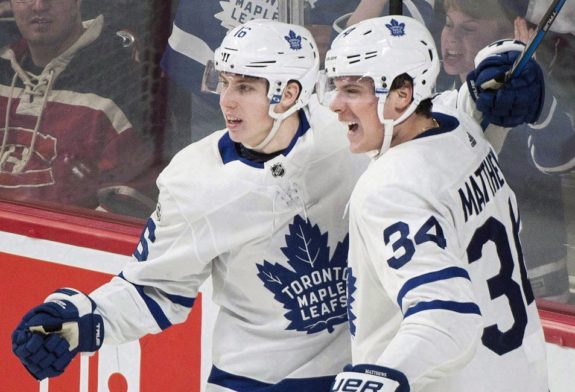
Could the lack of power play success be blamed on stale strategies and a lack of adaptation? Possibly. But there were also confounding factors behind the Maple Leafs’ struggles.
For one, the Maple Leafs had the fewest power play opportunities in the league with 211. This makes no sense. With skilled, shifty players like Matthews, Marner, William Nylander, and Morgan Rielly, you’d imagine that Toronto would find themselves towards the top of the league in regards to drawing penalties. The team’s lack of power play time, which can be attributed to questionable officiating, was at least a minor factor in their performance.
Despite the lack of power play time, Toronto’s unit ranked second in the league in terms of expected goals at 8.5-per-hour, only trailing the Pittsburgh Penguins’ mark of 8.7. This tells us that they were generating scoring chances at an incredible rate, but they were often stonewalled by opposing netminders.
All things considered, it would be unfair to criticize the power play too harshly. Yes, you’d expect better than eighth from Toronto’s roster, and maybe you could ask for more adjustments down the stretch, but assistant coach Jim Hiller had his units following the right process on the whole.
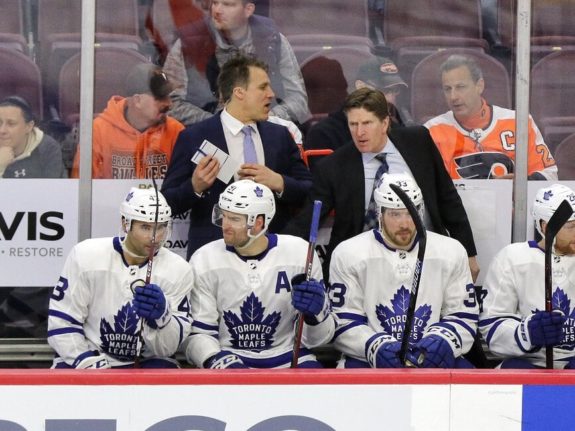
As per Elliotte Friedman, the Maple Leafs have given Hiller permission to interview with teams around the league, and he’s expected to leave this summer. Regardless of what you thought about the team’s power play, it will likely see some changes next season.
The Penalty Kill
Toronto’s penalty kill was league average last season, tied for 16th at 79.9 percent. And with the additions of players like Marner and Kasperi Kapanen to the penalty kill, there was an added dimension of offensive threat.
Where they really came undone was in the playoffs. If you had to summarize the Maple Leafs’ first-round loss to the Bruins in two words, “penalty killing” would be an acceptable answer. Toronto allowed seven power-play goals on 16 opportunities, giving them a dreadful mark of 56.3 percent on the penalty kill.
Assistant coach DJ Smith has been running Toronto’s penalty kill for the last four seasons, but this summer his contract will expire. It’s expected that he will also be moving on as several teams around the league have shown interest.
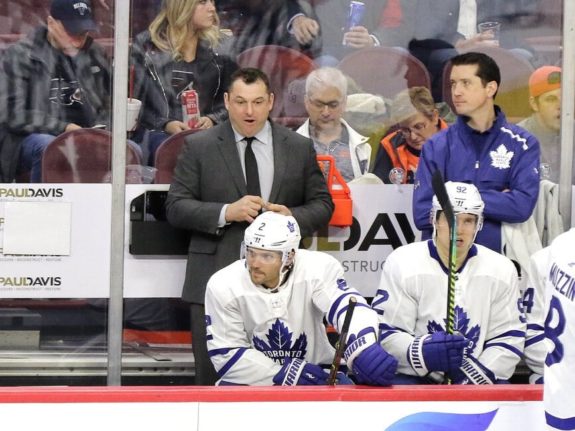
While it’s easy to blame Smith alone for the penalty kill, it’s still on the head coach to evaluate his team’s performance and adjust accordingly. We don’t know everything about Toronto’s inner team dynamics, but as the man in charge, Babcock should have stepped in to help his floundering penalty kill. To be fair, maybe he did. Either way, they still weren’t good enough. Once again, this area should see significant changes moving forward.
Leafs Ice Time
The Toronto faithful were warned about Babcock’s quirky (read: frustrating) tendencies four years ago. His overreliance on ineffective, past-their-prime veterans is nothing new, and unsurprisingly, history repeated itself, again and again. There were complaints in 2017-18 when Leo Komarov played 20 minutes a night on several occasions, and when a 37-year-old Ron Hainsey averaged nearly 22 minutes. Last summer, most of the grizzled vets were allowed to leave: Komarov and Roman Polak walked in free agency, while Matt Martin was miraculously traded. But even with a younger, more skillful lineup, the same issues remained: Babcock continued to rely on his veterans and grinders all the way to his team’s eventual downfall in Game 7.
In the most important game of the season, Matthews, Toronto’s leading scorer, played 18:48 – just 33 seconds more than Zach Hyman, who was later revealed to be playing on a torn ACL. Thirty-nine year old Patrick Marleau played 14:34 in a scoring role, while the energetic Trevor Moore toiled away on the fourth line with just over nine minutes of ice time. Fourth line centre Frederik Gauthier played 8:22 in a game where the Maple Leafs trailed for nearly 45 minutes.
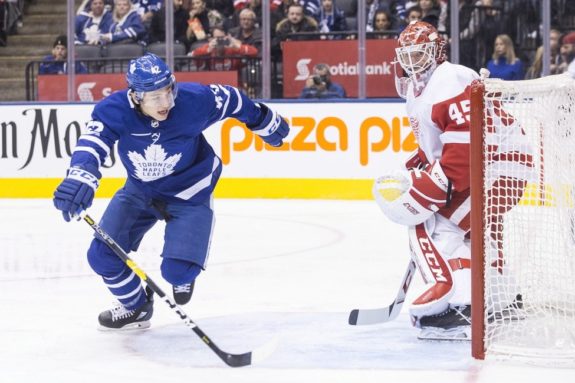
These ice time allocation issues persisted throughout the season and came to an unfortunate climax in the final game. It became patently clear how flawed Babcock’s decision making can be, and just how much the coach will need to evolve and adapt to keep up with today’s game. Everyone loves a hard worker but when it comes down to it, goals win you games, and that’s something he hasn’t fully embraced. If Babcock is going to finish his eight-year contract with the team, he’ll have to figure this out. Fast.
Leafs Line Combinations
Going hand in hand with ice time, line combinations have been a chronic issue for the Maple Leafs since Babcock took the helm. The playoffs, in particular, were strange as Babcock seemed to adjust well in some areas but poorly in others.
Hainsey, who faced top competition with Rielly all season long, was finally dropped down the depth chart. Babcock put Jake Muzzin and Nikita Zaitsev together towards the end of the season and, after they showed good chemistry, he correctly decided to use them as his shutdown pairing against Boston, allowing Hainsey and Rielly to be a bit more sheltered.
Conversely, Babcock didn’t handle his third line well at all. Following Nazem Kadri’s suspension in Game 2, he was forced to move Nylander to third line centre. The mistake came when Babcock left Marleau and Connor Brown on Nylander’s wings. Neither winger was particularly useful, especially in the offensive zone, and the line as a whole was generally ineffective. The obvious answer to this would have been to promote one or both of Moore and Tyler Ennis, who showed jump throughout the series.
Another more creative (and arguably more effective) idea would have been to reunite Nylander with Matthews, loading up the team’s top two lines. This is something that the Bruins obviously did to great effect throughout the season and in this series.
Despite Nylander’s well-documented struggles this past season, he and Matthews represented one of the most dangerous duos in hockey during their first two seasons together.
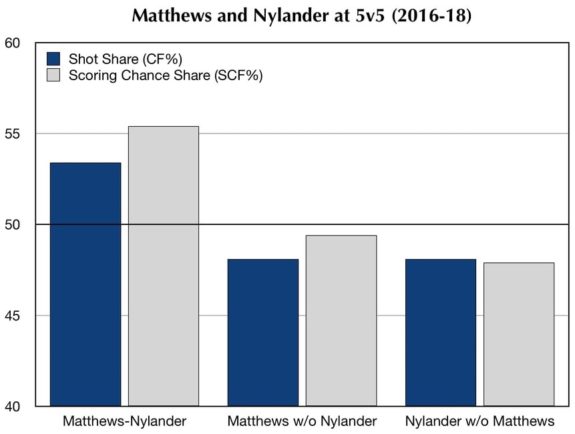
While Nylander often struggled to produce in 2018-2019, he and Matthews were still electric when given the chance to play with one another.
It’s evident that Matthews and Nylander have historically been dominant together. You can see it with your own two eyes, and the numbers agree: they handily outshoot, outchance, and outscore opponents whenever they play together.
Babcock should know all of this but instead of loading up and relying on his stars, he spread out the talent and in the process, spread his team thin. Matthews needs an elite playmaker like Nylander on his wing, which he didn’t have and Nylander needs to play alongside a sniper, which he didn’t have. It all added up to an underwhelming, sub-optimal lineup, and the Maple Leafs’ eventual demise.
Next Season Must Be Different
We know Babcock’s coaching style; we’ve seen it for the past four seasons. We know that, at least in part, it doesn’t work. He’s had a chance to do things his way, but his time is running out. If the Maple Leafs head coach wants to retain his job and ultimately win in Toronto, he’ll need to prove that he can evolve.
With a full year of experience as general manager, Dubas has gained more confidence, and he’ll need to make that message loud and clear to his coach. There’s already plenty of proof that Dubas is at least trying to assert his forward-thinking philosophies onto his team, but for his vision to come to fruition, he’ll need buy-in from the coach.
It’s time for Babcock to leave his ego aside and take a step into the modern game. The future of the franchise – and his career – may depend on it.
Player stats from hockey-reference.com and naturalstattrick.com
Team stats from NHL.com